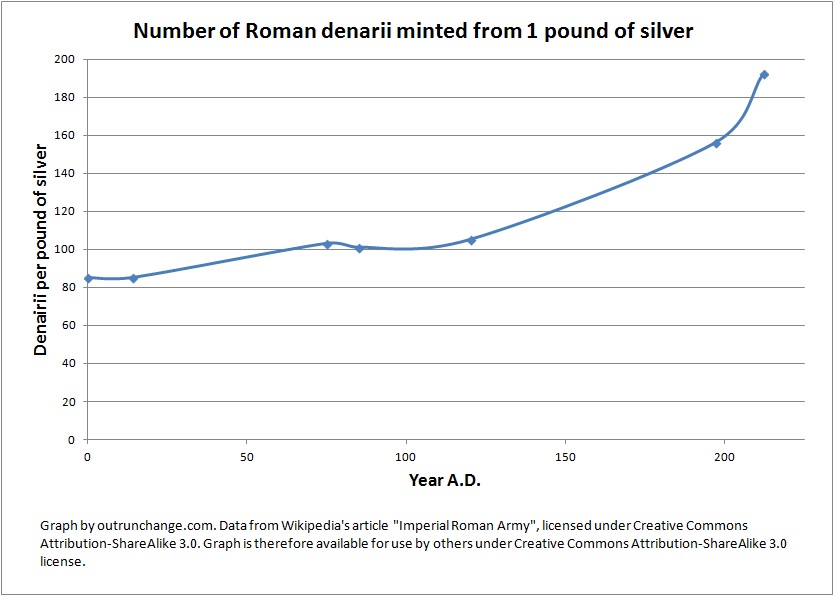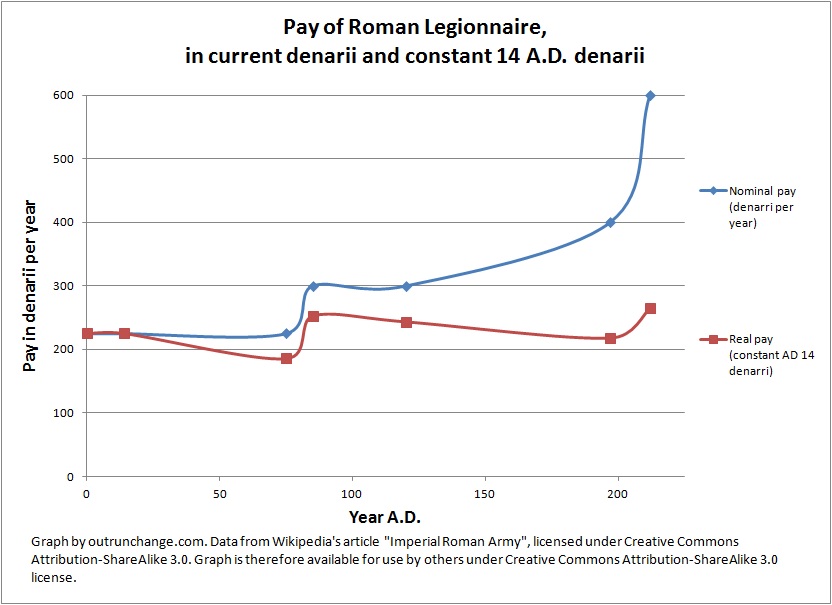
Pay for a legionnaire soldier in the Roman army increased substantially over time, from 225 denarii a year around the turn of the millenium to 600 denarri in the early 200s.
The amount of silver in a denarii was also steadily reduced over that same time. That is called inflation, which as we know from other reading, was driven by Roman Emperors intentionally debasing the currency as a way to help finance the empire.
A Wikipedia article, “Imperial Roman Army” provides data to analyze the gross pay and real pay over time.
First, let’s look at the declining value of a denarius. Here is the silver value of each coin, measured as the number of denarii minted from each pound of silver, along with my point estimate of the year of the change:
| Emperor | year | denarii per 1# silver |
| Augustus (to AD 14) | 14 | 85 |
| Vespasian (70-81) | 75 | 103 |
| Domitian (81-96) | 85 | 101 |
| Hadrian (117-38) | 120 | 105 |
| S. Severus (197-211) | 197 | 156 |
| Caracalla (211-8) | 212 | 192 |
Above data derived from “Imperial Roman Army” by Wikipedia; therefore others are licensed to use the table under Creative Commons Attribution-ShareAlike 3.0.
To better understand, what does that look like on a graph? Check out the above data, graphed with a smoothed curve.

Here is the actual pay by year in nominal, or current, amounts. This would be the actual number of silver coins paid each year.
Also listed is the constant amount, adjusted back to the equivalent value of denarii in 14 AD. The math consists of dividing the nominal pay by the denarii per pound in relation to the 14 AD denarii per pound. Real pay is rounded to nearest whole number.
| year | Nominal pay (denarri per year) | Real pay (constant AD 14 denarri) |
| 0 | 225 | 225 |
| 14 | 225 | 225 |
| 75 | 225 | 186 |
| 85 | 300 | 252 |
| 120 | 300 | 243 |
| 197 | 400 | 218 |
| 212 | 600 | 265 |
Above data obtained from “Imperial Roman Army” by Wikipedia; therefore others are licensed to use the table under Creative Commons Attribution-ShareAlike 3.0.
Keep in mind those pay raises are to catch up with the inflation that had already taken place.
The Wikipedia article cites a researcher who reports the inflation during that period of time was 170%. The increase from 225 denarii to 600 is a 167% increase.
For a visual presentation of the pay data, check out this graph:

Above data derived from “Imperial Roman Army” by Wikipedia; therefore others are licensed to use the table under Creative Commons Attribution-ShareAlike 3.0.
When adjusted for the debasement of the currency as an approximation for inflation and if you squint your eyes a bit, the long-term trend is for real pay to be around 225 sesterces a year until Emperor Domitian’s reign along about 85 A.D. or 90 A.D. when the real pay increased to somewhere around 250 sesterces a year.
Source data
I will include the raw data from the Wikipedia article, just as I’ve done with other posts in this series. This allows readers to double-check my info. This information is included under Creative Commons license.
By the way, all Wikipedia articles have that licensing, which means other people (like me) may use the material, with attribution, on the basis that the same license permissions apply to any use of the information and anything that is derived from the information. That means you are free to use my tables and graphs above on the condition that you also comply with the Creative Commons Attribution-ShareAlike 3.0 license.
So, as I am legally allowed to do, here is the data from Wikipedia for your consideration:
| REAL TREND OF LEGIONARY PAY (AD 14 – 215) | |||
| Emperor | Nominal pay of legionary (denarii) |
No. of denarii minted from 1 lb. silver |
Real pay of legionary (in constant AD 14 denarii) |
| Augustus (to AD 14) | 225 | 85 | 225 |
| Vespasian (70-81) | 225 | 103 | 186 |
| Domitian (81-96) | 300 | 101 | 252 |
| Hadrian (117-38) | 300 | 105 | 243 |
| S. Severus (197-211) | 400 | 156 | 218 |
| Caracalla (211-8) | 600 | 192 | 265 |
NOTE:Real pay calculated by dividing silver content of Augustan denarius (85 d. to lb) by the silver content of later denarii and multiplying by nominal pay
Above data obtained from “Imperial Roman Army” by Wikipedia; therefore others are licensed to use the table under Creative Commons Attribution-ShareAlike 3.0.